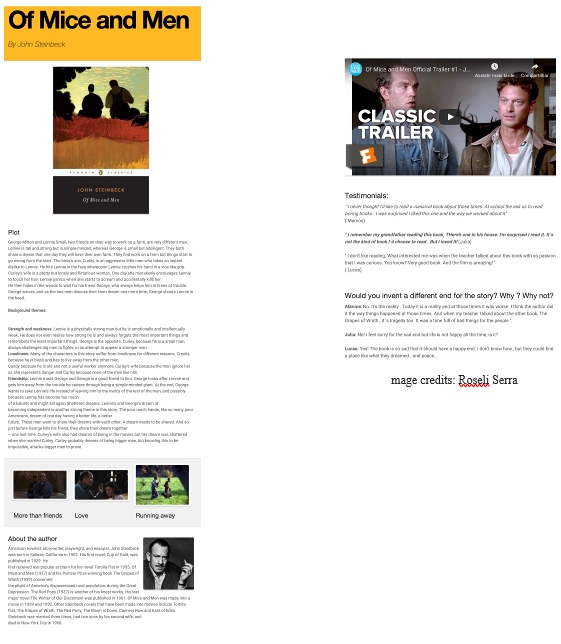- Home
- Various Articles - General
- Visual Didactics: The Use of Image the in Teaching- Learning Process in EFL
Visual Didactics: The Use of Image the in Teaching- Learning Process in EFL
Roseli Serra is an educator in Brazil. Graduated in English and Portuguese, she works as an ELT consultant, Cambridge Examiner and ELT teacher trainer in the area of TD and LT. She’s also a psychologist, a mentor and a coach with a post-graduate degree in Applied Linguistics and is now doing her MA studies in Science of Languages at UNICAP- Universidade Católica de Pernambuco – Cotholic Pernambuco University.

Abstract
Image-based communication has greatly influenced our lives in every way, especially with the advancement of Information and Communication Technologies (ICT). In this research, we proposed new methodologies, based on the use of multimodal resources, related to the teaching and learning of English Language (intermediate and advanced levels) of a private Language Institute in the Metropolitan Region of Recife. Our research is qualitative, of a longitudinal character. The corpus consisted of the activities proposed and carried out by teenagers, mostly using images from Google, Instagram and other applications installed on leaners' smartphones and posted on virtual platforms, such as: Glogster Edu (an online learning platform where you can creatively express yourself and what you have learned. It is an online multimedia digital poster that showcases your knowledge and includes embedded texts, audio, videos, images graphics, drawings, hyperlinks animation and documents) and Smore (a very user-friendly platform for presenting information. It works as a place to curate digital content for a virtual lesson. It includes text, links, embedded videos, images, forms and buttons), as well as YouTube and Vimeo videos. We bring the theoretical contribution mainly based on the semiotics (Santaella, Nöth (2012), Ribeiro (2015), on education (Freire 1967, 1997, 2005 and on the use of images Goldstein (2013 ) and Donaghy ( 2017) among others related to the areas above mentioned; The results of the screen research point to the effectiveness of the use of image and moving image in a digital environment, which leads us to conclude that such semiotic resources are successful in the teaching and learning of English Language.
Introduction
According to Confucius (551 BC - 479 BC): "A picture is worth a thousand words". Image-based communication has greatly influenced our lives in every way, especially with the advancement of Information and Communication Technologies (ICT). They have intensively become a part of our daily lives, and the information communication technologies allied to digital mobile technology have enabled people to build multiple identities.
The reading of images is present in several social media such as the internet, photography, picture books, and packaging, among others. According to Santaella (2012), the image is not only illustrative; it brings important information about the accompanying text, and may be present also without verbal language as a means of interacting with the public. The understanding of the codes for the understanding of the images enables access to the visual literacy, leading the subjects to read images.
This project aimed to propose new methodologies, based on the use of multimodal resources related to teaching and learning the English Language, as well as generate reflections on the process of teaching / learning and visual literacy and how effective the use of images engage students in the learning process, generate more speaking opportunities and give them a better sense of achievement.
As an avid reader, cinema, photography, arts fan and have been a teacher for over thirty-five years, I have played closer attention to the power of images, films and short videos mo. The fact that I have taught different age groups, including higher education, I have noticed that they are mostly visual learners. As for me, I must say I am a highly visual learner and teacher as well.
The interest of the research, therefore, arose from the need to verify pedagogical practices with the reading of images, as well as reflect upon the power of image and its impact both on teaching and learning by analysing the resources and theoretical tools present in the area of language learning and teaching of EFL (English as a Foreign Language) in order to generate reflections on the teaching / learning process and on visual literacy, since the current society is surrounded by visual images mainly reproduced through social media.
Identity construction from images on the Internet
According to Donaghy (2016) “images have all to do with the way we construct our personal and professional networks.” As I have previously stated, image-based communication has largely influenced our lives in all senses, especially with the recent shift to mobile technologies. Images have become part of our everyday life in a way people construct multiple identities. It seems that "successful” social networking depends on the construction of many identities to some extent. Identity regarding images has more to do with "what to do "rather than "who you are". You choose your public mask. And through our lives this is a constantly shifting as we take many different roles. We conclude then that the digital technology and social networks have empowered the use of images and changed teaching and learning. . Knowledge is also on the web. There's no way back.
Image reading
The concept of visual literacy is that it is easier and quicker to communicate a message with an image. It means that the importance of fostering a visual literacy has been taken seriously
The semiological knowledge transmitted, especially, to the new generations, is part of the collection left by the man through the image. Proof of this are the rock inscriptions that are constantly being found, surprising and stimulating researchers from the most different fields of knowledge. Therefore, it is not strange that the imaginary code coined by our ancestors, continue its course and advance in different ways, so that we cannot yet understand it in its totality, due to the complexity that constitutes it. Barthes (2005, p. 78), when referring to this theme, questions this knowledge and resorting to the epistemological order of the image: "First, what could be called the 'ontology' of the image: What is the image? How many types are there? How to classify them? Where does it begin? Where is it? " In view of these and other issues, we note that the extension of the globalization project that has altered, above all, the referential that guide the notion of human interaction, time and space, strongly involving visual language in contemporary society, is one of the educators, teachers and researchers. In this context, we observe that the imperative and general presence of the image in the daily life of contemporary human life is a reality on which demands a more overlapping view of us teachers about the visual volume that circulates in the school space.
An image constitutes the representation of something existing in day-to-day people’s lives. They are content published through social media, television, radio, film, photography, painting, and drawing, among others. According to Joly (2007), the contemporary image has been confused with advertising through of the television, forgetting of other visual creations that compose the images, such as painting or drawing. 424 According to Haddad (2008), the first images appeared during the prehistory, in which the man made paintings on the walls of the caves as a means of communication and represented real-world objects, which were always related to the culture of each people.
Likewise, images are also found in books, such as help to understand the text, or as the text itself, established only by images, which requires even more effort on the part of the reader so that it is possible to read and understand the message that the author wanted to convey with a particular image. To explain what she means by reading the image, Santaella (2012) uses the American visual expression literacy (visual literacy or visual literacy). According to the author, to read an image, "we should be able to part, as if it were a writing, to read it out loud, to decode it, as a code is deciphered, and to translate it, in the same way as we translate texts from one language to another " (Santanella, 2012, p.12).
Therefore, to be able to read images or to be visually literate, it is necessary to develop the observation of aspects and characteristic features existing within the image, but without going beyond thoughts that do not correspond to its true meaning. Just like a text, an image can also display several readings, but not any reading.
Goldstein (2013) points out that "at early education books are richly illustrated, but later on images give way to greater and greater proportion of verbal written text ". Latter pictures are usually treated as simply decoration or as a background for important texts. Text has been prioritized over image, which, many times, cause a "negative impact" on the learner who has suddenly made the transition from lots of images to lots of texts without, most of the times, being prepared to face such change.
Consequently, and unfortunately, texts may cause an opposite effect on our students because, sometimes, they do not seem to be interesting for the 21st century learners. Although words and pictures can signify the same thing, the effect they produce can be quite different. If we look at the image below the effect on viewer is probably different from what words would provoke.
On the other hand, Ribeiro (2015) claims that the division of words vs. image, is manichaeist and illusory.
[...] “an image can complement what was lacking in a word to say; a word can help you understand an image; a word can help to decode an image. [...] Hegemony of whom? A word and an image can exist in counterpoints and in synergies.” Ribeiro, 2015)

Although we are living in the so-called "image era," in general, teachers do not yet use teaching methods that make the image the departure for the construction of knowledge. There is also a predominance of oral and written language, "restricting visual support merely to the illustration of a knowledge given as duly elaborated "(Molina, 2007, 24).
Lima (2009, p.8) points out that:
[...] this change in educational paradigms, focusing on image as a methodological resource is part of the training of teachers, who are still walking slowly and often does not follow the evolution process or the problems appear in the day-to-day classroom, [...]. (Lima, 2009, p.88).
The author also comments that this change of approach must take place in order to meet the real needs of the school, leading to more interaction between the institutions and the educational reality. For this reason, it is crucial that teachers know how to consciously design pedagogical practices.
However, the absence of extensive systematic knowledge about the semiologies present in instructional materials used in schools, such as textbooks, posters, atlases, folders, pamphlets, as well as computer screens and multimedia equipment, are currently a kind of knowledge that challenges the studies in the field of education and the pedagogical practices. In this sense, Carlos (2006) addresses this issue:
It is curious that, despite the intensity and diversification of the use of the image in the contemporary world, it has not yet been adequately addressed in the school context as a pedagogical device for the treatment of knowledge. This can be very well demonstrated through the way the textbook positions the use of the image in the learning of school contents, as in the Portuguese Language. Let us say in passing: the textbook is an essential component of the cultural context of a literate society, spread mainly through schools. Given the order and hegemony of writing as a paradigm, the image inserted in the didactic book is not yet activated as a modality of text much less still as an epistemic text. (Carlos, 2006, p.88).
These reflections continue to be usable and are part of the didactic-pedagogical context, which is being updated through the advancement and insertion of new technologies, which bring to the daily school, multimodal texts, whose semiological combinations, are increasingly sophisticated.
Methodology
"Building senses in multimodal environments is a way of positioning yourself and others." (BARTON LEE, 2015 apud KRESCH et al, 2016)
Among the concerns that most challenge those who work with the image in school education is how to use visual text in the classroom, regardless of the support it presents and incorporate this text to the students.
Regarding this issue, the main objective of this project was to develop English language teaching practices as a foreign language, aimed at teenagers, mediated by the visual text and contribute to the understanding of the presence and use of the image in the didactic-pedagogical environment. From the knowledge and appropriation of the semiological power of the image, its possibilities to mediate in several forms the conventionally and culturally relations established in the social environment, as well as its power of representation with the objects of the real world, the image in the room of foreign language classroom can be a relevant tool for the teaching-learning process. Faheina (2008), who discusses this issue, states that:
When incorporated into the pedagogical field, the images give a new meaning to the activity to be performed. Thus, to use them as a mediator of learning gives meaning to the educational act, once, for every educational activity, there must be intentionality and a plan to be followed. (FAHEINA, 2008, page 46).
According to Paulo Freire’s (1967, 1997, 2005) writings which bear a rich philosophical, sociological and pedagogical reference, regarding this practice, some parameters must be presented as guides for this pedagogical approach. Thus, it is understood that the teaching work from the philosophical point of view must be guided by
"[...] a methodology that cannot contradict the dialogue of liberating education. Hence it is equally dialogical. Hence, while raising awareness, it also provides for the apprehension of the 'generating themes' and the awareness of the individuals around them. (Freire, 2005, p.101).
By understanding the concept of culture, it is from the social and existential universe of the learner that the conditions for expanding the process of teaching the language on screen are expanded to other vocabulary dimensions. In this perspective, words and images…
"[...] words that are used in the study of language, generators ... should be selected not because they are" technically well-chosen [...] "by the teacher, but because they keep and are full of sign elements connected to the learners vocabulary universe, their world (FREIRE, 1967, p.110).
According to Santaella (2015), images can be represented both in the quality of signs that represent aspects of the visible world as in themselves, as pure and abstract figures or colored forms. The difference between both ways of observation will be reflected, in the semiotics of the image, in the dichotomy of plastic signs.
Taking all these into consideration, this project was run for two years with four groups of teenage students of a language institute in Recife, Brazil. Learners’ proficiency level varied between A2 and B2 according to the CEF of languages. The project consisted of qualitative and longitudinal research and the corpus for analysis consisted of activities proposed by a teacher and carried out by teenagers mostly using images from Google, Instagram and other applications installed on learners' smartphones and posted on virtual platforms such as Glogster and Smore. Also YouTube videos and Vimeo videos were inserted in their visual projects.
It is important to highlight hat, as for this essay, we will present part of this educational project of reading, writing and oral production using images and videos on different online platforms aiming at presenting students projects as part of their continuous assessment dynamic assessment Unlike traditional assessment that focuses on the final product of what students have achieved, Dynamic Assessment (DA) seeks to find out how internalization occurs when care is provided. Traditional assessments define their goal as assessing the student's level or providing feedback for their study, the ultimate goal of Dynamic Assessment is to promote development and students’ progress is a lot more likely to occur (WEN, 2008).
Some ideas I have experienced with my students using multimodality
Regarding this project I decided to focus on multimodality, mainly images, for teaching and learning for two main reasons:
1. The use of multimodality in teaching and learning leads to higher teaching;
2. When we think about images nowadays we actually include videos, pictures, games, etc.,
which means the use of multimedia as it refers to any computer- mediated software or interactive application that integrate text, colour, graphical images, animation, audio sound, and full motion video in a single application.
Bearing this in mind, my two main aims were to make my teaching more interesting and to motivate my students by: raising interest in the target language they are supposed to learn, working on different projects along the semester and create an electronic portfolio on Edmodo, leading my students to be more digitally skilled once they have learned to use different types of media and images to produce language (both written and spoken) and finally leading them to a better sense of achievement once they produce and work with not only texts , but also images and different medias to present, produce and share ideas. Edmodo is an educational network that aims at providing teachers with tools to help them connect and communicate with their students and parents. Via the Edmodo app or website, teachers can share content, texts, videos, homework and assignments with their students online. Online tools to help teachers administrate their classes have recently grown in popularity – they are known as Learning Management Systems – LMSs. All the activities are adaptable and should be done according to student’s level of proficiency and interests. Check some of the ideas below:
Working with pictures
Ask students to bring pictures of their own. Suggest them use pictures from their cities, neighbourhood, trips, people, nature, personal interests, etc. they can work in pair or groups.
Activity 1: The couple in the picture
Outline: Students get into the mind of the characters and write up their mental storyboard, which builds up the final image. The focus is on narrative tenses for story creation using verb tenses such as present and past simple, past continuous, present and past perfect. As for group discussion present them with prompts (for the students to form questions) such as: Where they now? When first met? What circumstances? How long together? You imagine couple lifestyle? Family? Could describe them? This couple remind you of someone you know? Who? Why? Students discuss in groups and write a story about the image. After collective feedback, the teacher could ask students to compare their stories (differences and similarities) as well as do a follow up activity such as changing the end of their mates’ stories.

Activity 2: I’m relaxed
Focus on speaking. Outline: This activity works well as a warm up or to language presentation aiming at using -wh questions and physical descriptions. Ask students to take pictures about moments of relaxation from their holidays or weekends. They could pick them up from their personal social media or from their smartphones. Give them prompts such as: Who? How old? Where? What doing? Why wearing sandals? What else wearing? Etc. As a follow up activity students could describe each other’s pictures for the whole audience.

Activity 3: Reading and video projects on Glogster
Outline: To work on the theme ‘bullying at school’. Target language: second conditional. The choice of the film was negotiated with the students. In the classroom we played a snippet of the film and students were supposed to answer some questions such as: What’s the importance of being popular at school? How important it is for you to be popular at school? Choose some characters of the film and comment on what you think of them. Choose some scenes/ situations from the film and ask students to comment on what they think of them. Then choose some more scenes/ situations from the film and ask students to say what they would do if they were one of those characters. Each student (or pairs of students) are asked to create a Glogster poster about the film and add to their online portfolios on Edmodo. They not only produced texts, but also embedded videos from YouTube and Vimeo as well as created animated images in the platform.

Activity 4: Reading and video projects on Smore
Outline: This project was a partnership between the teacher and the students. Being at Upper Intermediate 2 level, those students were supposed to read a book to be assessed for an international exam. The reader was the classical book Of Mice and Men by John Steinbeck. As the age of the students were between 15 and 16 years old, the teacher decided to make them aware of the story context and invited them to do some research and build up the poster together with her. There were 8 students in the group who worked in two groups of four and to work on peer reading, to produce writing and do oral presentation. It was a six-week project considering the reading of the book and the production of the activities and the poster. To foster their curiosity students were said asked to create an acrostic poem from the word MICE. To present the students with the context a pre-reading activity was done in order to make them understand that was a trouble in the town called Weed and think about what happened. Some related questions were on the interactive white board screen so that they could find the information on the book, reflect, discuss and give feedback. A handout for dictionary work with some words and expressions such as farmhand, throw it away and living off the fat of the land, was given to the students. Leaners were also asked to find interesting things in the pictures of the book and make a list of five things they like the most. After oral feedback, students were asked to make assumptions about what was going to happen in the story. They had 3 weeks to read the book, ask questions and participate in a discussion forum in our Edmodo group. The teacher as invited to interact with the students. Instructions to build up the Smore collaborative writing poster on the book plot were on posted on the Edmodo virtual classroom, on the upper-intermediate 2 group. As for the collaborative writing they made a chain story based on two suggestions: a word document and a Livetyping Creation activity (livetyping.com is a web tool where everything you write or erase is recorded in real time). Students negotiated with the teacher that they would divide the collaborative writing into chapter and each pair of students would write about a certain number of chapters. Having the poster ready and presented orally, a follow up activity was added by the teacher on their poster. It consisted of some further questions such as if they would change or not the end of the story and why. Their answers were posted on Edmodo and generated another debate, giving the students another chance to interact once more, practice writing, develop their critical thinking and gave them the chance to give opinions and enrich their vocabulary.

Analysis of the results
Second Language Acquisition has undergone great changes in the last decades. Different theoretical perspectives made language teachers and curriculum developers behave and think differently about how language learners should learn a second language. Vygotsky's Socio Cultural Theory (SCT) states that social interaction and cooperative learning are fundamental in constructing both the cognitive and emotional images of reality as Vygotsky has stated: "children's thought and meaning-making are socially constructed and emerge from their social interactions with their environment "(Wen, 2008).
The results of this project point to the effectiveness of the use of image and moving image in a digital environment, which leads us to conclude that such semiotic resources are successful in the teaching and learning of the English Language. Regarding language acquisition, the proposals presented here are possible and have proven effectiveness, with successful results. Changes will occur from other methodological concepts in the universe of teaching and language acquisition, as well as in the diversity of student profiles that will certainly have other needs which will promote adjustments in the teachers as well.
As for semiotics and multimodality, the results were significant, since leaners analyzed images, created texts and rewrote stories, in different formats of representation of the text and containing variety of semiotic resources: images, videos and animated images, for example, producing multimodal written texts. Therefore, from practices of reception students could understand the significant whole and, from this, develop their own textual production.
Final considerations
We observed that working in a multimodal environment has made significant changes in the teaching and learning practices in the EFL classroom for several reasons teaching and learning have become much more interesting, the projects raised interest in the target language and in the English language itself; working on different projects along a certain period of time and creating an electronic portfolio not only motivated students but also made them sure that the teachers was always their side helping them learn and build up knowledge rather than correcting or assessing them only; students have learned to work with different medias and, consequently , they became more skilled and able to vary their learning strategies and use of tools; having a higher sense of achievement learners have also improved their critical thinking skills as well as the use of self-evaluation.
Finally, we believe that learning occurs effectively when students interact with one another in foreign language classrooms. Regarding this particular project we conclude that learning took place as a result of shared experiences in a variety of multimodal contexts.
References
Barthes, R.(2005) Imagem e moda. Tradução de Ivone C. Benedetti. São Paulo. Editora Martins Fontes.
Carlos, E.J.(2006) O emprego da imagem no contexto do livro didático de língua portuguesa. In: Temas em Educação. João Pessoa.v. 15, n. 1, p. 87-100.
Donaghy, K. and Xerri, D. The Image (2017) Malta. Gutemberg Press.
Faheina, E.F.A. (2008) A formação do pedagogo no contexto da cultura midiática: unindo as novas linguagens e as práticas interdisciplinares. In CARLOS, E. J. (org.). Por uma pedagogia critica da visualidade. João Pessoa. Ed. Universitária da UFPB,
Freire, P. (1967). Educação como prática da liberdade Rio de Janeiro. Editora Paz e terra
Freire, P. (1997) A importância do ato de ler São Paulo, Cortez Editores.
Freire, P. (1987) Pedagogia do oprimido. São Paulo. Editora Paz e Terra.
Haddad, L. G. (2008) A Ilustração Literária. Londrina. Editora Ilustres Ideias.
Goldstein, B (2013) Working with Images. Cambridge. Cambridge University Press.
Joly, M. (2007) Introdução à análise da imagem. São Paulo. Papirus Editora.
Kresch, D. F. ; Coscarelli, C. V. ; Cani J. B. (2016) Multiletramentos e multimodalidade: ações pedagógicas aplicadas à linguagem. Campinas, SP: Pontes Editores.
Lima, C. R. O Uso da Leitura de Imagens Como Instrumento Para a Alfabetização
Visual (2009) .In: Portal dia-a-dia educação. Available on <http://www.diaadiaeducacao.pr.gov.br/portals/pde/arquivos/2483-8.pdf>. Last seen on : 17th May 2019.
Molina, A.H. (2007) Ensino de História e Imagens: Possibilidade de Pesquisa.
Domínios da Imagem, Ano I, n.1, p. 15-19,
Ribeiro, A. E. Textos Multidomais: leitura e produção. São Paulo: Parábola Editorial,
Santaella , L.; Nöth, W (2015) Imagem: cognição, semiótica, mídia São Paulo: Iluminuras.
Santaella, L. (2012) Leitura de imagens. São Paulo. Editora Melhoramentos,
Vygotsky, L.S. (1987) Problems of general psychology, In R. Reiber & A. Carton (Eds.) The Collected Works of L. S. Vygotsky. New York. Plenum Press.
Wanderley, L.E.W. (2010) Educação popular: metamorfoses e veredas. São Paulo: Editora Cortez.
Please check the Creative Methodology for Using ICT in the English Classroom course at Pilgrims website.
Please check the Practical uses of Technology in the English Classroom course at Pilgrims website.
Please check the Practical uses of Mobile Technology in the English Classroom course at Pilgrims website.
Visual Didactics: The Use of Image the in Teaching- Learning Process in EFL
Roseli Serra, BrazilLanguage, Teaching and Interaction: Reflections on the Concept of Language Present in Brazilian Teaching Documents
Sweder Souza, BrazilThe Black Dog in the Classroom: Mental Health in ELT
Fernando Guarany, Brazil